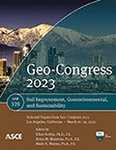Negative Effect of Tannic Acid on the Strength of Cement-Stabilized Soil
Publication: Geo-Congress 2023
ABSTRACT
Organic matter in the soil makes a deep mixing project challenging since these organics interfere with cementitious reactions. It reduces the strength of cement-stabilized soil and/or delays the strength development, thereby requiring more cement to achieve the target strength of the project. A research program is ongoing to investigate the influence of organic matter on the strength of cement-stabilized organic soil and develop a framework for quantitative prediction of the strength of cement-stabilized organic soil. In our previous research, the effect of six organic compounds on the strength of cement-water slurry was tested, and tannic acid showed the strongest negative effect on the strength. This paper presents the finding of a laboratory study into the influence of organic matter on the strength of cement-stabilized fabricated clay with tannic acid. A fabricated lean clay (CL) and tannic acid at various concentrations were mixed with water and then blended with a cement-water slurry at various mix designs. The mixture was placed into a plastic mold and cured in plastic containers of water in the humidity-controlled room at room temperature for 3, 7, 14, and 28 days. After curing, unconfined compressive strength (UCS) test or laboratory miniature vane shear test was performed on cured samples. The test results show that the strength of cement-stabilized soil with tannic acid increases with curing time and the amount of cement added to the mixture, while it decreases with the increasing concentration of tannic acid. In this study, tannic acid proved its detrimental effect on strength development in cement-stabilized soil as well as cement-water slurry. In other words, tannic acid reduces the strength, but the negative effect of tannic acid is reduced by adding more cement or applying a longer curing time. Additionally, a threshold to overcome the negative effect of tannic acid was observed, and it was controlled by not only the amount of cement but also curing time and tannic acid concentration.
Get full access to this article
View all available purchase options and get full access to this chapter.
REFERENCES
Åhnberg, H., and Holm, G. (2017). “Stabilization of some Swedish organic soils with different types of binder.” Dry Mix Methods for Deep Soil Stabilization, Routledge, 101–108.
Babasaki, R., Suzuki, K., Saitoh, S., Suzuki, Y., and Tokitoh, K. (1991). “Construction and testing of deep foundation improvement using the deep cement mixing method.”, Publ by ASTM, 224–233.
Bennett, M. D. (2019). Effect of Concentration of Sphagnum Peat Moss on Strength of Binder-Treated Soil. Virginia Polytechnic Institute and State University.
Bruce, M. E. C., Berg, R. R., Filz, G. M., Terashi, M., Yang, D. S., and Collin, J. G. (2013). Federal Highway Administration Design Manual: Deep Mixing for Embankment and Foundation.
Chen, H., and Wang, Q. (2006). “The behaviour of organic matter in the process of soft soil stabilization using cement.” Bulletin of Engineering Geology and the Environment, Springer, 65(4), 445–448.
Chowdhury, I. N., Abedin, M. Z., and Arif, M. Z. U. (2016). “Stabilization of Organic Soil from Bangladesh with Cement and Fly Ash.” 19th Southeast Asian Geotechnical Conference & 2nd AGSSEA Conference (19SEAGC & 2AGSSEA) Young Geotechnical Engineers Conference, Kuala Lumpur, 95–98.
Clare, K. E., and Pollard, A. E. (1954). “The Effect Of Curing Temperature On the Compressive Strenghth Of Soil-Cement Mixtures.” Géotechnique, 4(3), 97–106.
Clare, K. E., and Sherwood, P. T. (1954). “The effect of organic matter on the setting of soil-cement mixtures.” Journal of Applied Chemistry, 4(11), 625–630.
Abrams, D. A. (1920). Effect of Tannic Acid on the Strength of Concrete. (Lewis Institute. Chicago, ed.), Structural materials research laboratory.
Fang, Y. (2021). Low-cost, ubiquitous biomolecule as next generation, sustainable admixture to enhance the performance of ordinary portland cement-based concretes. The University of Alabama, Tuscaloosa, AL.
Hebib, S., and Farrell, E. R. (2003). “Some experiences on the stabilization of Irish peats.” Canadian geotechnical journal, NRC Research Press Ottawa, Canada, 40(1), 107–120.
Hodges, D. K., Filz, G. M., and Weatherby, D. E. (2008). Laboratory mixing, curing, and strength testing of soil-cement specimens applicable to the wet method of deep mixing.
Janz, M., and Johansson, S.-E. (2002). The function of different binding agents in deep stabilization.
Ju, H. (2019). Influence of Curing Temperature on Strength of Cement-treated Soil and Investigation of Optimum Mix Design for the Wet Method of Deep Mixing.
Ju, H., Brand, A. S., Abdelaziz, S. L., and Filz, G. M. (2022). “Influence of Organic Matter on Strength Development of Cement-Water Slurry.” Geo-Congress 2022, American Society of Civil Engineers, Reston, VA, 129–137.
Kang, G., Tsuchida, T., Kim, Y., and Baek, W. (2017). “Influence of Humic Acid on the Strength Behavior of Cement-Treated Clay during Various Curing Stages.” Journal of Materials in Civil Engineering, American Society of Civil Engineers (ASCE), 29(8), 04017057.
Kitazume, M., and Terashi, M. (2013). The Deep Mixing Method. The Deep Mixing Method, CRC Press.
Li, X., Xu, R., and Rong, X. (2012). “Assessment of strength development in cement-admixed artificial organic soil with GX07.” Journal of Central South University 2012 19:10, Springer, 19(10), 2999–3005.
Nevarez-Garibaldi, R., Miller, D., and Filz, G. (2018). Influences of Mixture Proportions and Test Conditions on the Strength and Stiffness of Wet-Mixed Soil and Cement,.
Tremblay, H., Duchesne, J., Locat, J., and Leroueil, S. (2002). “Influence of the nature of organic compounds on fine soil stabilization with cement.” Canadian Geotechnical Journal, NRC Research Press Ottawa, Canada, 39(3), 535–546.
Zhu, W., Chiu, C. F., Zhang, C. L., and Zeng, K. L. (2009). “Effect of humic acid on the behaviour of solidified dredged material.” Canadian Geotechnical Journal, 46(9), 1093–1099.
Information & Authors
Information
Published In
History
Published online: Mar 23, 2023
Authors
Metrics & Citations
Metrics
Citations
Download citation
If you have the appropriate software installed, you can download article citation data to the citation manager of your choice. Simply select your manager software from the list below and click Download.
